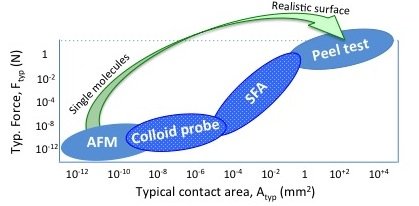Adhesion Reloaded: lnteraction Forces and Functional Materials
Nowadays, the replacement of toxic chromate based adhesion promoters by environmental-friendly alternatives is becoming reality in industrial applications, which use adhesives or adhesion-promoting substances e.g. for galvanically coated steel sheets or Aerospace adhesives and sealants. Beside self-assembled films, which are currently intensively investigated, biomimetic concepts (e.g., borrowed from musselfootproteins) are debated as environmental friendly, biodegradable green alternatives for adhesion promoters and glues.
Scaling of interactions, starting from single molecule up to multiple molecule interactions
The fundamental understanding of scaling of molecular interactions is a key-knowledge for prediction and prevention of degradation processes at composite materials interfaces, such as wet de-adhesion or electrochemically driven corrosive de-adhesion of polymers. Manipulation of single molecules, in particular measuring the mechano-chemistry of single molecules and probing their adhesive interactions have become state-of-the-art in interface science. However, a fundamental understanding and rationalization of the scaling of interactions, starting from single molecule up to multiple molecule interactions at solid-liquid interfaces remains an unexplored topic.
The novel electrochemical surface forces apparatus (EC-SFA). Unravelling of structure/property relationships at electrified interfaces
Markus Valtiner and his group "lnteraction Forces and Functional Materials" newly designed the electrochemical surface forces apparatus (EC-SFA), which is a central new experimental technique available at the MPIE. This unique set up allows for a simultaneous measurement of time dependent adhesion and friction forces, and absolute surface-surface separations between opposing electrified interfaces.

The new adhesion science and friction labs, which are fully operational since May 1st, allow now to test adhesion and friction at extended length and force scales, providing the means to understand macroscopic adhesion and friction phenomena based on their molecular level details. Currently, the group operates 2 AFMs (one is currently being equipped with tip enhanced Raman), one SFA-2000 and is setting up peel-test equipment.
Correlation of molecular recognition forces and macroscopic adhesion forces
The "lnteraction Forces and Functional Materials" group was established in June 2012. Future projects will focus on the direct correlation between friction forces and damage within friction traces by a combined approach of SFA (macroscale), AFM (micro- and nanoscale) and highresolution imaging and elemental mapping techniques. Likewise, the investigation of adhesion and in particular the correlation of molecular recognition and macroscopic adhesion forces - based on design and synthesis of adhesion promoting and structure guiding molecules - will be a central focus of the group.
The technological interest of the group covers aspects from thin film coatings, surface roughness effects, electro-deposition of polymers, adhesion promoters and glues for automotive and aerospace applications to functional-bio-motivated materials for responsive coatings and sensing applications.
Selected Publications of M. Valtiner
